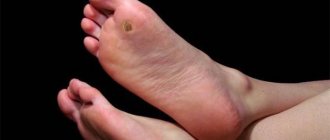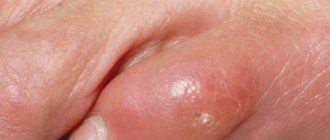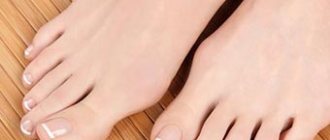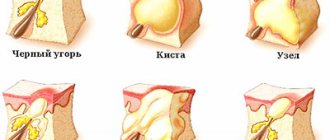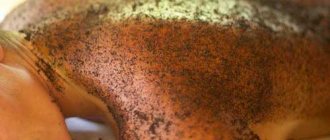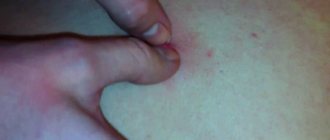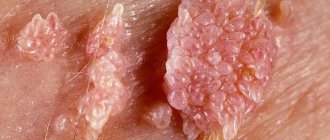Natalia Babich
Calluses, especially water calluses, or wet calluses, as experts call them, are a common phenomenon in our lives. Everyone has encountered it at least once. This is especially true for the fair sex, when the desire to have beautiful, albeit uncomfortable, shoes outweighs all arguments about impracticality. And only many, having discovered liquid in a callus, are amazed: what kind of misfortune is this, and how to get rid of it?
Signs of infection
There are water and blood calluses. They differ in their contents: the first are filled with transparent liquid, the second, purple in color, are filled with blood. Any of them can fester. An infected callus requires immediate treatment; it is recommended to immediately consult a specialist to prevent the occurrence of blood poisoning and prevent the infection from spreading throughout the body. Most often, inflammation of the callus is observed on the toe and heel due to wearing tight shoes.
The main symptoms of callus suppuration:
- Change in color of exudate (liquid in the callus);
- The appearance of redness and inflammation around the callus;
- Discharge of pus;
- Sharp pain when touched;
- There may be a slight increase in body temperature.
Inflammation around the callus and discharge of pus
If you notice that a callus is festering, then take action immediately!
Medications
Today's pharmacological industry offers a wide range of products for local treatment of ingrown calluses on the feet and to get rid of the callus. This includes special gels, creams, solutions and patches.
Keratolytic agents. Creams or liquids that often contain salicylic acid. The substance has a pronounced keratolytic effect and is good for getting rid of excess stratum corneum of the epithelium on the legs. However, it is recommended to treat calluses with such means with caution. The effect often extends to healthy areas of the skin, causing irritation and the formation of ulcers.
Mechanism of infection
A callus with pus most often appears when the blister is not treated and antiseptic rules are not followed when treating it. An open callus is a gateway to infection, so it must be isolated from the surrounding aggressive environment.
Purulent exudate (liquid inside the callus) consists of dead leukocytes that protect the body from pathogenic bacteria and dangerous infections. Its appearance indicates that the immune system is working properly. But in our body there is a single network of blood vessels, thanks to which oxygen and nutrients reach the organs and tissues. The same transport system can lead to the spread of infection, which can lead to sepsis (blood poisoning), embolism (blockage of blood vessels) and gangrene.
What kind of liquid is in calluses?
Having reached a certain size, the bubble bursts, and in such cases a wound remains on the skin, sometimes quite large. This process is accompanied by the leakage of some clear liquid similar to water from the damaged area. So what comes out of the callus and why?
Ignorant people have the misconception that there is water in the callus. However, this is not at all true. The fluid colloquially called "water" is actually called lymph, or lymphatic fluid. Translated from Latin, “lympha” means “moisture”. Lymph is also called “tissue fluid”. This is due to the fact that it surrounds every cell of our tissues with liquid, where the blood delivers nutrients and also carries away the products of their breakdown. The formation of lymph itself is a complex combination of water and other substances from the blood in the intercellular space.
If water flows from the callus, it means that some mechanical force caused it to rupture. Usually this is squeezing, impact or friction. This yellowish, watery substance, found throughout the human body, circulates through all tissues of the body. It collects bacteria, fats, and other unnecessary compounds and filters them through the lymphatic system. It contains leukocytes (lymphocytes) and a small concentration of proteins and red blood cells.
Lymph itself operates in the lymphatic system, which is connected to lymph nodes - small nodules that act as filters. They trap harmful substances. It is this network of vessels and capillaries that is responsible for the production of fluid and white blood cells.
Treatment with professional methods
It is recommended to ask your doctor how to treat a purulent callus. This disease is dealt with by specialists in purulent surgery; only a professional will be able to properly open and drain a festering blister in order to prevent infection. If improperly processed and incompletely pumping out the contents, purulent calluses can recur, and the infection can spread through the blood vessels throughout the body. After the procedure, broad-spectrum antibiotics are prescribed to prevent infection.
Three main ways to remove purulent callus in a medical institution:
- If the callus is cored, the root is drilled out by a surgeon using a specially selected cutter of a certain size. Antiseptic drugs are instilled into the resulting wound to prevent re-festering.
- The laser immediately coagulates (cauterizes) nearby blood vessels, so pathogens do not spread through the blood vessels. Healing time is 3-5 days
- Cryotherapy is the most effective treatment method. During the procedure, healthy skin is not affected; only the purulent callus and its contents are removed. Usually carried out in advanced cases when a lot of pus has accumulated.
Professional callus removal
Getting a problem known as an ingrown callus happens quickly, but removing the formation is much more difficult. Many professional methods of combating calluses, medications and traditional medicine recipes have been developed.
Professional callus removal methods are quick and convenient. They practice in specialized medical and cosmetology clinics.
- Drilling is carried out in beauty salons, where pedicure services are provided. The master has special equipment. A cutter suitable in size is selected. The core of the callus on the feet is carefully drilled out, taking care not to damage the surrounding healthy skin. It is important that the drilling removes all of the stem tissue. If a couple of tiny particles remain inside the skin, the callus will quickly grow back and will be much more difficult to get rid of again. When drilling is completed, the cavity is filled with salicylic acid.
- Laser surgical treatment is used in severe cases. The laser scalpel acts on the core of the callus, allowing you to get rid of the root without affecting the surrounding healthy tissue. At the same time, the laser beam destroys the viral and fungal infection that sometimes accompanies the callus. The advantage of the described method of radical removal is the possibility of precise dosing of the effect. The laser surgery method is bloodless, low-painful, and leaves no scars.
Do not try to do home treatment and cut out the callus with a razor blade. Firstly, it is easy to cut yourself and get an infection; subsequent treatment will be carried out by doctors in the surgical department. Secondly, with the help of a blade it will not be possible to remove the entire shaft; soon the callus will grow again.
Self-treatment
Not everyone has the opportunity to see a doctor right away, so many people ask the question: “A callus on my foot has festered, what should I do?” In the first days of the development of the disease, you can try to solve the problem yourself, using medications or folk recipes.
Medications
When you detect the first signs of the disease, you need to know what to do if the callus is inflamed. Doctors recommend using Vishnevsky ointment or Levomekol. To do this, you need to apply a thick layer of the selected drug to the festering area, then seal it with a band-aid or wrap it with a sterile bandage for a day. It is advisable to keep your foot at rest for the duration of treatment; you should not wear tight shoes. The dressing is changed twice a day. The next day the pus should come out.
Vishnevsky ointment
When changing the dressing, the purulent callus is treated with hydrogen peroxide, furacillin or chlorhexidine.
Folk recipes
You can try treating an infected callus using home recipes. These techniques are simple and effective, and the ingredients for them are available in every home.
A leaf of aloe, peeled and tied to the sore spot overnight, is good at drawing out pus. Lemon pulp will also help get rid of suppuration if applied overnight. In the morning, you need to rinse your leg with warm water and apply a bandage.
Try a salt compress to get rid of the callus. Dissolve 1-1.5 tbsp. in 1 glass of water, moisten a swab or cotton wool and apply to the blister for 2-3 hours. The mixture softens the skin, stimulating the removal of exudate. The procedure can be combined with the use of anti-inflammatory ointments, repeating them 2-3 times a day.
The onion peel tincture is prepared simply: onion peels are infused in vinegar for 7 days, then they are taken out and applied overnight to the affected area.
Folk recipes
If the callus is festered and swollen, foot baths can help. For their preparation, ingredients that are found in every home are used.
- Pour warm water over baking soda (3 tsp) and baby soap (1 tbsp), and soak your feet in the mixture for 30 minutes. This recipe will help relieve inflammation and soften rough skin.
- Salt baths reduce pain and swelling. To prepare them, table or sea salt dissolved in warm water is used. The duration of the procedure is 20-30 minutes.
Important:
Any of the listed remedies should be used no more than 48 hours after the appearance of a festering blister. If home therapy for an infected callus does not produce any results, then you need to seek help from a specialist, only he can help get rid of the disease without consequences.
Core callus - Features of treatment
There are several methods of treating education, from which you need to choose based on two criteria:
- Why did the problem arise?
- What stage is she in?
The second aspect is especially important: severe cases can only be cured with radical methods available to the medical clinic; all others will be useless.
On the other hand, if the callous formation is shallow, then it is quite possible to remove it at home.
A consultation, as well as an examination by a doctor, will help you understand how deeply the root has grown. He will also recommend an effective treatment method.
Tips to avoid infection
A purulent callus requires long-term and unpleasant treatment, so it is better to avoid its appearance. To do this, just follow these simple tips:
- Choose comfortable shoes and socks of the appropriate size;
- Give preference to shoes made from natural materials, do not wear synthetic socks;
- Pay attention to the health of the skin on your feet: lubricate with Vaseline the places most susceptible to rubbing calluses.
- If a blister appears, do not neglect treatment: be sure to treat it and cover it with a band-aid to prevent infection;
- Watch your weight - obese people have a higher risk of developing purulent calluses.
The appearance of pus is the body’s protective reaction to infection, but if the callus festers, it is advisable to immediately consult a specialist. If it is not possible to visit a specialist, then you can use medication and folk methods to eliminate the blister. Home therapy is carried out for no more than 2 days; if a positive trend is not observed, then you need to consult a doctor to prescribe treatment. An infected callus can lead to blood poisoning, blockage of blood vessels, and even gangrene.
Causes of callus formation
- Long-term and regular mechanical impact, for example, among dancers or lovers of constantly wearing high-heeled shoes. The higher the latter, the greater the load on the pads under the fingers, which contributes to skin damage.
- An old splinter can also cause a callus because, being inside an area of the body that is subject to regular stress, it injures the skin.
- An ordinary callus can turn into an internal callus if left untreated for a long time.
- Old age itself is a cause of ingrown callus formation, as the skin becomes less elastic and thick over time.
- Infection can become an impetus for the appearance of internal callous formations. In this case, they must be removed as soon as possible and only in the clinic, because not only the rod will have to be eliminated, but also the infection.
Modern removal methods
Consult a dermatologist about removing growths on the soles of your feet and toes. There are effective, painless methods that allow you to get rid of even overgrown formations. A beauty salon or beauty clinic will offer you several effective methods.
Professional methods for removing callus:
- laser removal. The method is effective in advanced cases. The laser beam is capable of burning the rod to the ground. Another advantage is that during the procedure, pathogenic bacteria that have penetrated the affected area are destroyed. For this reason, the risk of developing an inflammatory process after the procedure is reduced to zero;
- hardware callus removal. The doctor uses a special device to “drill out” the formation. It is important to completely get rid of the rod. After the procedure, an antifungal or antibacterial agent is placed in the canal. A correctly performed procedure usually does not cause complications. The risk of relapse is minimal;
- cryodestruction. Removing growths using liquid nitrogen is one of the proven methods. Low temperatures “burn out” the painful lump along with the central part. Less than a minute - and the tissues are destroyed. With complete removal, re-germination is virtually impossible.
Corn plaster
The Salipod callus patch was created specifically to combat ingrown calluses An effective, easy-to-use remedy will relieve painful formations in a short time.
Of course, there are exceptions, sometimes the patch does not help. Most likely, a fungal or viral infection is to blame in this case. You can’t do without special creams and ointments.
- wash your feet, dry them;
- Apply “Salipod” to the affected skin and secure it with an adhesive plaster on top;
- keep the patch on the callus for 3 days;
- after the expiration date, remove “Salipod”;
- steam your feet, remove the rod;
- if the core is deeply ingrown, repeat the procedure;
- usually the rod comes out, leaving a hole;
- treat this area with iodine and cover it with an adhesive plaster.
What do pharmacies offer?
If there is a virus in the body, then antifungal and antiviral drugs will be needed.
In addition, you can purchase the following medications at the pharmacy:
- Anti-callus patches. For example, Salipod, which contains salicylic acid, which helps soften dry calluses.
- Ointments and special creams work the same way as the patch. Nemozol is especially worth highlighting.
- Products containing herbal ingredients and acids.
How to treat ingrown calluses?
The main thing you should know is no self-medication! Such formations are strictly not allowed to be cauterized, cut out, steamed, or treated with caustic compounds or “magic” ointments. All methods not recommended by the doctor often lead to skin damage, which will lead to the dynamic growth of deep calluses. First a dermatologist, then treatment. Only a doctor can determine the dynamics of the course and development of the pathology, the depth of germination of the rod. Depending on these factors, treatment will be determined and medicinal, surgical or traditional methods of treatment will be prescribed.
Instructions for use of Feresol solution and substitute analogues
Important! A viral fungal infection, which is typical in the presence of a black callus with a dot, can quickly spread to healthy areas of the skin if self-medicated. Curing the disease will become much more difficult.
Symptoms
Most often, ingrown calluses occur as a result of improper treatment of water calluses ; when the bubble bursts and the mechanical action continues. At the initial stage, a slight tingling, itching, burning sensation is felt, which, with the formation of a core, turns into a dull pain, which especially causes a lot of problems when walking. It is easy to determine the presence of an internal rod: it is very painful when pressed . Lameness appears, wearing shoes becomes torture. If an infection occurs, the root callus may fester.
